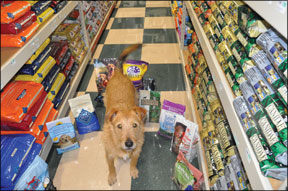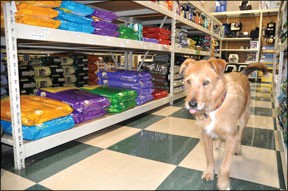How should you select a food for your dog? Over the years, we’ve spoken to literally thousands of owners and industry experts – and they have at least a few hundred different approaches to the task. We’ll briefly discuss some of the most prevalent factors used by owners to support their dog food buying decisions – and then we’ll tell you how we recommend choosing your dogs’ food.

Price – There is a correlation between the price of a dog food and its quality, but it’s most accurate at the low end, and less certain when you get to the upper price points.
What is certain is that inexpensive food is not what’s healthiest for your dog. Think about it: Cheap food is made with cheaper ingredients. We shudder to think of what sort of ingredients go into a product that sells for 25 cents a pound. Think about what is commonly called “4-D” meat: animals that are dead, dying, diseased, or disabled. Think about grain by-products of unknown provenance being shipped all over the planet – rejected for use in human food and languishing in warehouses while ingredient brokers try to find a buyer.
Good- and top-quality ingredients cost more, and the companies that use them have to charge more, so a high price can be an indication of quality. But higher prices can also be indicative of a company’s advertising budget, or the higher costs associated with running an independent pet supply store in a remote area.
At the top of the price range, there’s a bit of wiggle room. We’ve seen hamburger-quality foods that are sold for filet mignon prices. The market tends to correct matters if a company leans out too far, seriously overrepresenting its quality and overpricing its mediocre foods. Such a product can’t perform as well as one that’s really that good. Even just a few dozen owners whose dogs have persistent diarrhea after eating a really expensive food can stir up quite a storm on the Internet.
Ingredients – We hope that you do use the ingredients list to help you choose the food. But there are people who look at ingredients differently than we do.
For example, some owners insist on buying only those products whose manufacturers can provide proof (or at least, allege credibly) that all the food’s ingredients are domestically sourced – no ingredients from China. In the wake of the melamine recalls, I don’t blame those people one bit. There is no doubt that there are some really crummy food ingredients steaming across the oceans heading for American pet food plants.
On the other hand, we’ve also had pet food companies exhaustively describe the quality controls they employ to ensure that their Chinese-grown chicken (as one example) is as safe, wholesome, and less expensive than any fowl grown in North America. As a result, we can’t justify making a blanket recommendation for or against food based on the country of origin of their ingredients alone. In our view, this is a matter that has to be considered case by case. If a company won’t either confirm the origin of its major proteins and grains or explain the quality control processes it employs to guarantee the purity and wholesomeness of its foreign-sourced ingredients, we’d take a pass on its products.
Then there is the concept of “no” – as in “no corn, wheat, or soy…” “No fillers.” Or our personal favorite: “No allergens” (that’s impossible, folks).
There are a few ingredients that are commonly identified as undesirable in dog food: corn, wheat, and soy, most frequently. Some authors (or competing pet food companies) go so far as to allege that dogs can’t digest these ingredients, which is just plain silly; dogs digest these ingredients every day. None of these ingredients is inherently unhealthy for all dogs. Each has some benefit – for some dogs, in moderate amounts, and in the least-processed form possible. A certain percentage of dogs – a minority, for sure – may be allergic to (or more likely, intolerant of) one of the those ingredients. This doesn’t mean the ingredients don’t offer some value for most dogs. That said, we like to see them serve in a supporting, not a leading role. The protein and fat they offer have more nutritionally valuable (and of course, more expensive) counterparts in other ingredients. Their appearance in any of the top few places on an ingredients list signals a less-expensive, poorer-quality food. But their presence in a food lower down on the list doesn’t “kill” that food for us – unless we are feeding a specific dog who doesn’t tolerate one of those ingredients.
We’ve also seen screeds against beet pulp, tomato pomace, alfalfa meal, and other ingredients. Each of these ingredients offers some nutritional or functional benefits, such as helping to regulate the dog’s stool quality. Again, we don’t mind seeing them serve a supportive role in an otherwise healthy food.
Finally, there are a number of other factors having to do with ingredients that some people use to make the buying decision for their dog’s food. Some owners look for food with ingredients that are organic, local, non-GMO, or humanely raised and killed. Each of these can be found in some products; each raises the price of the finished food exponentially.

Our view is that if ingredients of this quality are important to you, you should forget about kibble; you could certainly prepare a more healthful diet for your dog using fresh ingredients. (Installments of Mary Straus’ series of reviews on the best books about various types of home-prepared diets were published in the December 2010 and January 2011 issues of WDJ; the next article will appear in the March issue.)
Past history – This is another place where we may differ with some of our readers. Some people won’t buy any product that has ever been recalled, for any reason. Other people won’t buy foods that are manufactured at a plant that made another food that was once recalled. After all, accidents can be an indication that the company’s quality controls are lax.
We certainly understand the fear that drives the consumers who make buying decisions based on a company’s recall history. And yet, we’re aware that sometimes, it’s the folks who have made a costly mistake who do the best job of ensuring that they won’t ever make another one. Companies tend to make huge investments in training and safety protocols after a recall.
Any company can suffer one manufacturing accident. That said, if accidents or recalls happen more than once . . . well, where there’s smoke, there is often fire.
Size of the company – Some people don’t trust corporate giants like Procter & Gamble (owner of Iams, Eukanuba, and more recently, all of the Natura Pet Products foods) or Colgate-Palmolive (owner of Hill’s Science Diet).
It’s the nature of manufacturing that always seems to pit quality against production efficiencies. We love the care and attention that small pet food companies can put into procuring top-quality, local, organic (or at least sustainably grown) ingredients. We appreciate their relentless drive to innovate healthier foods for dogs. But we worry about the manufacturing irregularities that can result in small plants (which are often running outdated equipment and inadequate quality control tests). We’re also concerned about products that are formulated by amateurs in animal nutrition and marketed without enough feeding trials to determine that the foods will perform as well in the dog as they did in the nutrition software.
In contrast, the giant food companies can put some of the most educated veterinary nutritionists to work in their research and development departments, furthering the industry’s knowledge of animal nutrition. They have the resources to build and maintain glistening state-of-the-art food manufacturing facilities, and hire, train, and retain armies of food production workers that produce consistent, safe products. But they don’t usually develop and support top quality products.
Either way, we consider the size of the company that’s behind each product we buy for our dog and retain the information as background when considering its potential merits or faults. But the company size doesn’t make the buying decision for us.
Company-owned manufacturing plant vs. “contract manufacturer” – As recently as a few years ago, pet food companies who used contract manufacturers (also known as “co-packers”) were often reluctant to admit they didn’t make their own products. But there are some real merits to not owning the plant, especially for small companies – precisely the ones who often bring something new to the industry or who have formulated unique and/or atypically high-quality foods. The costs associated with buying, equipping, and maintaining pet food manufacturing plants are enormous, but paying a co-packer for a bit of time on their machines can benefit both parties.
The challenge, though, is keeping a close enough eye on the co-packer, to make certain it uses your specified ingredients in the specified amounts, keeping accurate batch records, keeping your product separate from the other products in the plant, etc., etc. A pet food company’s reputation is incredibly vulnerable if it fails to monitor and audit its co-packer (though the co-packer will surely be blamed for anything that goes wrong with the food, even if it followed its client’s instructions to the letter).
Is it better, then, if the company owns its plant? In some cases, yes. But only if the company is big enough to maintain the plant well (we’ve seen some incredibly scruffy little manufacturing plants). And as we previously discussed, sometimes the biggest, cleanest plants produce some of the lowest-quality foods around. They do it well, though.
For these reasons, the actual ownership of a pet food’s manufacturing plant isn’t a selection criterion for us, though it is something we want to be aware of.
Method of confirmation of nutritional adequacy – Most veterinarians come out of school promoting the superiority of foods that have undergone Association of American Feed Control Officials (AAFCO) -compliant feeding trials (versus those that have been “formulated to meet the nutrient levels” recommended by AAFCO). It’s no wonder; veterinary nutrition textbooks have been written and/or published by the company whose products are all tested in these very expensive trials.
But the fact is, foods should be tested on dogs before they go to market; some products that seem brilliant in theory just don’t perform well in actual dogs.
All foods that purport to be “complete and balanced” (as opposed to “for supplemental of intermittent feeding only) must bear a statement on the label that indicates which method of confirmation was used to support the claim. (The type might be really small; look carefully!)
When buying a food confirmed as “complete and balanced” by the AAFCO “nutrient levels” method, ask the maker of your dog’s food whether and how the product was tested on dogs – for how long, and on how many dogs. Some companies conduct their own (non-AAFCO-compliant) feeding trials on dogs that they maintain in private kennels; others use a network of breeders or shelters who volunteer for these tests (free food!). (For a more complete discussion of the relative merits and faults with the various methods for proving nutritional adequacy, see “Take It With a Block of Salt,” WDJ February 2007.)
Picking a food for your dog
We’ve discussed a lot of factors we don’t necessarily use to choose our dog’s food. So how do we make our selection?
First, we try to shop locally. (This may not be possible for people who live in remote areas, but there is always online shopping and mail order, and fortunately, there are numerous companies with good products that available via direct shipping.) We try to scout out every location that sells pet food in our area, to get a sense of which ones carry which foods. We also talk to the shop owners or staff, in order to get a sense of which stores seem interested in serving our type of dog owner: motivated, educated, and willing to spend more than the average customer for really good food.
Then we look at the product labels, examining the ingredients lists. We use the criteria outlined below (“Hallmarks of Quality” and “Signs of Corners Cut”) to determine which (if any) of the foods carried by the store are in the range of quality we’re willing to pay for.
We note the products that meet our selection criteria, and write down the names of any companies we’re not familiar with, so we can do a little more research on them once we’re back home.
If there are stil several products in the running, we then look for the one that best matches our dog’s needs for protein, fat, and calories, using his body condition (fat, thin, or just right?) and activity level (highly active or couch potato?) to choose a product in the appropriate range. Unless he’s emaciated or obese (and in need of a high-calorie or “light” food, respectively), we look for a product whose calories, fat, and protein levels are in the middle range of the products that are still in the running.
At this point, we’ve decided which brand and variety to buy, but before we grab the bag from the top of the pile, we look for the “best by” date on the bag. Most naturally preserved dry foods are given a “best by” date that is 12 months from the date of manufacture. Try to find a bag that is as fresh as possible, rather than one that is near, at, or past its “best by” date. If every bag of food of the variety you selected is nearing its expiration, we’d recommend choosing another variety, or asking a sales associate when she expects a new shipment to arrive. This stuff is too expensive, and your dog’s health too important, to buy potentially rancid food.
Make a note on your calendar when you start feeding a new product to your dog, and note any changes in his health. Adjust accordingly.
“Approved foods”
Click here to see this article in its entirety with Whole Dog Journal’s 2011 list of “approved foods”. Please note that we have listed the foods alphabetically by company; they are not rank-ordered.
Some companies make several product lines. We’ve listed each product line that meets our selection criteria from each manufacturer. We’ve also highlighted one product from each company as a representative, to show what sort of ingredients and macro-nutrient levels (minimum amounts of protein and fat, and maximum amounts of fiber and moisture) are typically found in that maker’s foods. Be aware that some companies offer dozens of different products with varying nutrient levels and ingredients. Check the company’s website or call its toll-free phone number to get information about its other varieties.
We say this every year, but it bears repeating: What if your favorite dog foods don’t meet our selection criteria? It’s up to you. If you have been feeding what we would consider to be low-quality foods to your dog, and she looks and appears to feel great, good for you! She’s one of those genetically lucky animals who can spin straw into gold, digestively speaking. But if she has allergies, chronic diarrhea, recurrent ear infections, or a poor coat, we’d recommend that you upgrade.







Hello,
We have a new puppy with digestive issues. She came to us eating Wellness dry and pedigree chopped chicken, it was mixed together but, she never seemed to like it, I have been struggling for her to eat and now she is refusing the dry altogether.
She is a 3 legged mix dog, she is 7.months old. I am concerned about her joints as she grows only having 3 legs but, she also has stomach issues, I have bought Fortiflora to add to her food…she doesn’t like it and refuses to eat. I don’t know what to do at this point…I have stopped giving her all dry food (I trused a few other at the suggestion of friends…not great foods.
I am looking at Purina Pro Plan Savor for puppies, it has active probiotics and glucosamine due to meat or chicken by products.
I can not afford expensive food, I have a cat who is already on prescription dry food, our vet suggested prescription foods for our pup, we haven’t tried but, 2 different otc dry food. Our pup has loose/mushy stool and gas. She has not had that for the past 2 days I have been giving her rice, chicken and the canned food.
Can you advise? I am overwhelmed with all the choices of foods out there.
I appreciate any information. Thank you,
Carol
I have my 2 picky dogs on Merrick lamb dry and a little wet(little.plates) they love it!!
Please make some chicken broth and give her a few tablespoons at a time with it luke warm. It’s good for a lot of things as is chicken bone broth, especially for those joints.
Try cooking plain rice and boil some chicken see if she will eat this, you can always add other nutrients if needed. But the basic is pretty bland and easy on the stomach.
I’m trying to find yr 2019 Best Dry Dog Food List! This was one of the items I espiecially was looking for when I subscribed to yr site & magazine. Please direct me as to where I can find it.
Thanx
Yr articles are great, but I need the list!
I am a member and really love your issues…however my concern, (major concern) is all dog food reviews are from the US only and not any from Canada. That is the main reason for my membership…I do love all the articles and information but I have two rescued labs that are 9 years old and have bad allergies. I am hoping you may incorporate foods reviewed from Canada. Thanks so much.
Like Judith Mancini, I would like to see an updated list of Best Dry Dog Foods. I’ve fed one of the varieties of Blue Buffalo for years now but recently have heard some negative reports. Would be interested in your take.
Thanks,
JoLynn O’Shea-Walker
I also have a dog with allergies and I was very interested in the list of dog foods… where can I find it ??
I have concerns a out the grain free foods the FDA claims to be the cause of Dilated Cardiomyopathy. I feed Taste of the Wild which I’ve had wonderful results with for many years but is on this list. I would like some answers pkease!
I would also like the 2019 list of preferred dog foods for our new golden retriever puppy. I’m overwhelmed with all of the choices and different messages I’ve read about grain or no grain diets.
I would also like the list of 2019 Best Dry Dog Foods
I also wanted a list of best dog food for 2 boarder collie neutered males.
Need list of 2019 Dry dog foods, I did sign up for your $30 two (2) year membership as well …Cynthia Walsh
Your list of approved dry dog foods is from 2011! This is almost 2020. I just paid for a subscription to this site and for a list of approved dog foods, which I assumed would be current, not old and outdated. Please update list so I know what you recommend for my new rescue puppy. Thank you.
I feel an echo, and a bit of nimrod, especially because it never occurred to me that I would not be receiving a current list of dry dog foods when I paid for my subscription. Come on, Journal, current info and recommendations, please?????
Agree with the previous complaints. This looks misleading or even deceitful. I paid to see specific recommendations for kibble in 2019.
I’m trying to log on to yr 2019 Dry Dog Food List of best foods & have been finding everything but that! I ama subscriber, how do I get the List? That is one of the main reasons I selected to purchase yr publicaton!
Please help🐶🐾thanx
I have been feeding home cooked food always. I’m from Europe and when I was little there was no commercial animal (pet food) anyway. So here when I am in the US I combine ( whenever possible) organic meat with veggies and potatoes or rice. My current dog is a rescued mix about 14 lbs who licks the bowl clean and as usual begs for more. And as much exercise as possible. When we are in my country she runs around off leash as much as possible, loves to dig for rabbits. Much of her hunting instinct is expressed on long walks and yes she is healthy now, has overcome this horrible heartworm with which she was rescued.
Would you like to live off canned or commercial food also? That’s how I feel.
Is your latest list really from 2011? How can that be? That’s the only reason I signed up is to get the 2019 best dog foods!
I feed my dog Merrick dog food lamb and potato what is your opinion on it.? I feel as if it’s a good dog food my dogs love it very much. Diana Wright 2019
Dog food
I use the Whole Earth brand which is either made by Merrick or they use the same plant. I am not sure. My dog likes it and seems healthy except for some minor itching. I also supplement with some fresh meat like chicken, turkey or homemade soup with the above meats. Sometimes a little bit of rice.
I have a chi- mix and he is 1yr old just a day ago. He is shedding very bad I’ve been trying different foods none seem to help. Don’t know if it’s allergies or what’s. I have tried Biljack,Noutrich,Blu-wilderness , name a few. Nothing is helping . Any ideas will help. He’s a rescue.